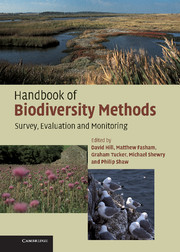Book contents
- Frontmatter
- Contents
- Preface
- Acknowledgements
- Part I Planning
- Part II Habitats
- Part III Species
- 9 Introduction to species assessment
- 10 General principles and methods for species
- 11 Fungi
- 12 Lichens
- 13 Bryophytes
- 14 Aquatic macrophytes and algae
- 15 Vascular plants
- 16 Dragonflies and damselflies
- 17 Butterflies
- 18 Moths
- 19 Other terrestrial invertebrates
- 20 Aquatic invertebrates
- 21 Fish
- 22 Amphibians
- 23 Reptiles
- 24 Birds
- 25 Bats
- 26 Other mammals
- Appendix 1 Monitoring and reporting obligations under international conservation agreements
- Appendix 2 Relationship between BAP Priority Habitat and Broad Habitat categories and Habitats Directive nomenclature
- Appendix 3 Annotated list of key references for plant identification
- Appendix 4 Determining appropriate quadrat size for vegetation sampling
- Appendix 5 The relocation of permanent plots
- Appendix 6 Equipment required for undertaking different types of survey
- Recommended sources of further information
- References
- Glossary
- Index
22 - Amphibians
Published online by Cambridge University Press: 01 September 2010
- Frontmatter
- Contents
- Preface
- Acknowledgements
- Part I Planning
- Part II Habitats
- Part III Species
- 9 Introduction to species assessment
- 10 General principles and methods for species
- 11 Fungi
- 12 Lichens
- 13 Bryophytes
- 14 Aquatic macrophytes and algae
- 15 Vascular plants
- 16 Dragonflies and damselflies
- 17 Butterflies
- 18 Moths
- 19 Other terrestrial invertebrates
- 20 Aquatic invertebrates
- 21 Fish
- 22 Amphibians
- 23 Reptiles
- 24 Birds
- 25 Bats
- 26 Other mammals
- Appendix 1 Monitoring and reporting obligations under international conservation agreements
- Appendix 2 Relationship between BAP Priority Habitat and Broad Habitat categories and Habitats Directive nomenclature
- Appendix 3 Annotated list of key references for plant identification
- Appendix 4 Determining appropriate quadrat size for vegetation sampling
- Appendix 5 The relocation of permanent plots
- Appendix 6 Equipment required for undertaking different types of survey
- Recommended sources of further information
- References
- Glossary
- Index
Summary
Amphibians have a terrestrial and an aquatic phase to their life cycle, with the larvae being exclusively aquatic until they metamorphose. Adults return to water every year to breed but spend a proportion of each year on land. Amphibians also hibernate over winter. Most surveying and population monitoring of amphibians focuses on population studies of adults at breeding sites. It is important to remember that the numbers of amphibians counted by using most methods are influenced by air and soil temperature: a cold spell may reduce activity considerably. This must be taken into account when comparing studies between years or between sites or when assessing a site as part of an EIA study.
ATTRIBUTES FOR ASSESSING CONDITION
Population size
Estimates of population size for amphibians are generally best made during the mating season, when most adults will be gathered at their breeding sites. Breeding population size can therefore be estimated for each pond, with a total estimate for an area obtained by totalling numbers from each pond. This will probably be an overestimate of population size, because movement between ponds is likely.
Breeding success
Whether or not amphibians are breeding successfully can generally be examined in two ways. First, egg searches will establish if mating has taken place and eggs have been laid. With some species, population estimates can also be made from the number of egg clusters. Second, trapping larvae at various stages of development will establish whether eggs are hatching and larvae are surviving.
- Type
- Chapter
- Information
- Handbook of Biodiversity MethodsSurvey, Evaluation and Monitoring, pp. 387 - 403Publisher: Cambridge University PressPrint publication year: 2005
- 1
- Cited by



